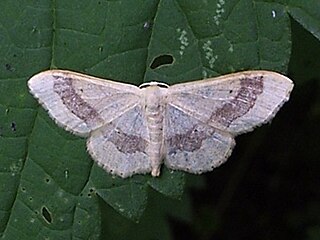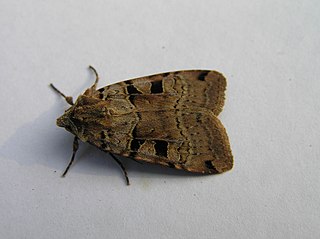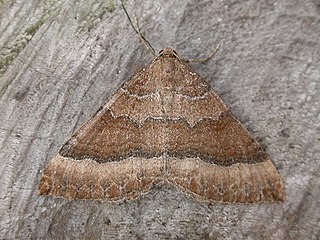
The small fan-footed wave is a moth of the family Geometridae. The species was first described by Johann Siegfried Hufnagel in 1767.

The riband wave is a moth of the family Geometridae. The species was first described by Carl Linnaeus in his 1758 10th edition of Systema Naturae.

The tawny speckled pug is a moth of the family Geometridae.

The double square-spot is a moth of the family Noctuidae. It is distributed through most of Europe except the Mediterranean islands and northernmost Fennoscandia. In the East, the species ranges East across the Palearctic to Siberia and in the South-East to the Black Sea and in Iran. It rises to a height of about 2,000 metres (6,600 ft) in the Alps.

Eupithecia innotata, the angle-barred pug, is a moth of the family Geometridae. The species was first described by Johann Siegfried Hufnagel in 1767. It ranges from Spain in the west to western Siberia and Central Asia in the east.

Idaea dimidiata, the single-dotted wave, is a moth of the family Geometridae. It is a Holarctic species.

Idaea muricata, the purple-bordered gold, is a moth of the family Geometridae. It was first described by Johann Siegfried Hufnagel in 1767 and is found in the Palearctic.

Hylaea fasciaria, the barred red, is a species of moth in the family Geometridae. The species can be found in central and northern Europe, the Urals, Caucasus, Altai and eastern Siberia.

Macaria alternata, the sharp-angled peacock, is a moth of the family Geometridae. It is found in Europe, Turkey, the Caucasus, Georgia and South Siberia.

Macaria notata, the peacock moth, is a moth of the family Geometridae. It is a Holarctic species.

Macaria wauaria, the V-moth, is a moth of the family Geometridae. It has a Holarctic distribution. The species was first described by Carl Linnaeus in his 1758 10th edition of Systema Naturae.

Mesoleuca albicillata, also known as the beautiful carpet, is a moth of the family Geometridae. It is found in the Palearctic.

Idaea fuscovenosa, the dwarf cream wave, is a moth of the family Geometridae. It is found in the Palearctic.

Idaea straminata, the plain wave, is a moth of the family Geometridae. It is found in Europe including West Russia and Balkans.

Eupithecia tantillaria, the dwarf pug, is a moth of the family Geometridae. It was described by Jean Baptiste Boisduval in 1840. The species can be found in the Palearctic realm.

Larentia clavaria, the mallow, is a moth of the family Geometridae. The species was first described by Adrian Hardy Haworth in 1809. It is found from Siberia in the east to the Iberian Peninsula, North Africa, and the British Isles in the west. In the north it ranges to the Caucasus, Tajikistan and Fennoscandia. In the south it is found the western Mediterranean islands, Italy, the Balkans and Asia Minor. It occurs only locally and is almost always rare. In the Alps, it rises up to 1200 m above sea level.

Hydrelia sylvata, the waved carpet, is a moth of the family Geometridae. It is found throughout the temperate parts of the Palearctic realm.

Jodis lactearia, the little emerald, is a moth of the family Geometridae. The species was first described by Carl Linnaeus in his 1758 10th edition of Systema Naturae. It is found throughout the Palearctic realm, from Ireland to Japan.

Eupithecia venosata, the netted pug, is a moth of the family Geometridae, first described by the Danish zoologist Johan Christian Fabricius in 1787. It is found across the Palearctic realm from Portugal and Morocco in the west to the Lake Baikal in Siberia and Afghanistan and Pakistan in the east.

Eupithecia trisignaria, the triple-spotted pug, is a moth of the family Geometridae. It is found from across the Palearctic realm from Europe to Siberia.






















